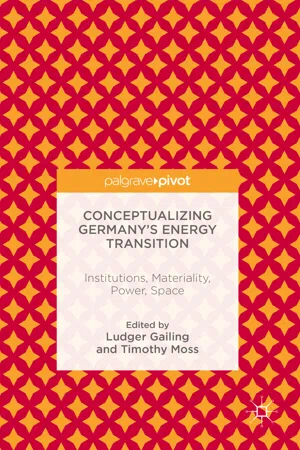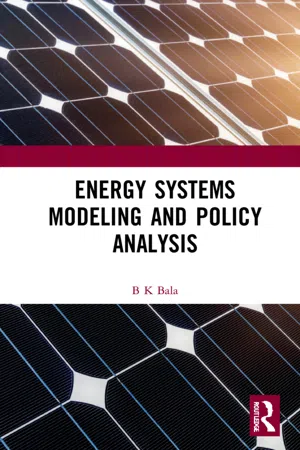Energy Supply and Demand
Energy supply and demand refers to the balance between the amount of energy available and the amount needed. It encompasses the production, distribution, and consumption of energy resources such as fossil fuels, renewable energy, and electricity. Understanding energy supply and demand is crucial for addressing energy security, sustainability, and environmental impacts.
3 Key excerpts on "Energy Supply and Demand"
- eBook - ePub
Conceptualizing Germany's Energy Transition
Institutions, Materiality, Power, Space
- Ludger Gailing, Timothy Moss, Ludger Gailing, Timothy Moss(Authors)
- 2016(Publication Date)
- Palgrave Pivot(Publisher)
...Human geographers claim to analyse not only ‘the distribution of energy-related activities across a particular space’ but also ‘the underlying processes that give rise to these patterns’ (Bridge et al. 2013, p. 333). They explore how energy transitions are embedded in wider political and economic contexts which shape significantly the processes and outcomes of each transition. Current developments such as climate change and the increasing scarcity of natural resources have spawned growing interest in energy questions within the field of human geography (Bouzarovski 2009). Key issues addressed by energy geography include the materiality, social construction, representation, distribution and appropriation of energy resources (Huber 2011). Furthermore, energy geography deals with geopolitical dimensions, such as the global political economy of the energy sector , and international energy relations as well as the importance of scale to energy governance (Bosse 2011). The local and regional impact of structural changes within the energy market —such as energy poverty—is an emergent topic for energy geographers (Buzar 2007). In addition, economic geographers are also active in researching innovation in the energy sector (Fornahl et al. 2012). Given this wide spectrum of issues and approaches, there is no common coherent theoretical framework guiding energy geography. Indeed, energy geography remains under-theorized (Jiusto 2009). Those theoretical approaches used are inspired, for instance, by neo-Marxist thinking (Huber 2009), ANT (Cupples 2011) or institutional economics (Venjakob 2012). Overall, the value of energy geography lies in the insights it provides into the social production of space via energy transitions, including impacts of uneven spatial development and the scalar relations and socio-spatial materiality of energy. 6.3.2 Political Science In political science, a discussion on urban energy and climate governance began over a decade ago...
- eBook - ePub
- Zhenya Liu(Author)
- 2015(Publication Date)
- Academic Press(Publisher)
...Supply 123 4.2 Large-Scale Clean Energy Bases on Each Continent 124 4.3 Distributed Energy Development 150 4.4 Development and Utilization of Fossil Energy 153 5 Global Electricity Flow 157 5.1 Reasoning and Principles Behind Global Electricity Flow 157 5.2 Overview of Global Electricity Supply 159 5.3 Electricity Supply and Demand Balance on Each Continent 162 5.4 Development Trend of Global Electricity Flow 172 Summary 181 1. Major Factors Nowadays, energy development is closely associated and aligned with socioeconomic development. It determines the close link that Energy Supply and Demand has with economy, society, the environment and resources. Generally speaking, socioeconomic development, energy resource endowment, energy environment constraints, technological progress, and energy policy regulation are the five major factors that influence Energy Supply and Demand (See Fig. 4.1). In particular, socioeconomic development, including economic and population growth, industrialization, and urbanization, determines the growth trend of gross energy demand and regional distribution. The reserves and distribution of energy resources determine the supply potential, structure, and distribution of energy. Energy and environmental constraints restrict the overall level, structure and way of mankind’s utilization of energy resources to meet energy demand. As the Earth’s ecological environment deteriorates, its impact on energy consumption, supply structure, and structural readjustment has become increasingly prominent. Energy technological advancement and energy policy regulation mirror the combined effect of science and technology and government regulation on economy, energy, and the environment. Energy technological progress is a major decisive factor in directly determining the efficiency of energy production and consumption as well as environmental emissions...
- eBook - ePub
- B K Bala(Author)
- 2022(Publication Date)
- CRC Press(Publisher)
...5 Modeling of Energy Demand, Supply and Price DOI: 10.1201/9781003218401-5 5.1 INTRODUCTION Energy demand is increasing globally in order to meet the needs of increasing populations and economic growth. Fossil fuels are still the main sources of energy and contribute to global warming, and furthermore, they are being depleted rapidly. This has prompted the transition to environmentally friendly renewable energy resources to ensure energy security and to reduce the contribution to global warming. System dynamics modeling methods for understanding the dynamics of Energy Supply and Demand, energy price and contributions to global warming from energy production are presented in this chapter. 5.2 ENERGY DEMAND We use energy in different forms, such as biomass or gas for cooking, electricity for lighting and air-conditioning, petrol for driving cars, and diesel for running buses for transport and tractors for cultivation. Therefore, energy is demanded in different forms. Global demand is increasing rapidly and is related to GDP. The energy demand sector estimates and projects the demands for energy for different uses and total energy demand, which mainly depends on fast-growing populations and economic growth. It also depends on income and location, such as rural and urban (Bala, 1998). The electric power system is one of the most important energy sectors, and the demand analysis and load forecast of this sector are well-established. Accurate metered consumption data are available. However, errors in demand forecasts are more serious since large investments and long construction delays are associated with the expansion capacity of the electric power system. A forecast that is too low may lead to a short-term solution or load-shedding, which affects economic growth and industrial development...


